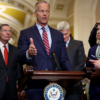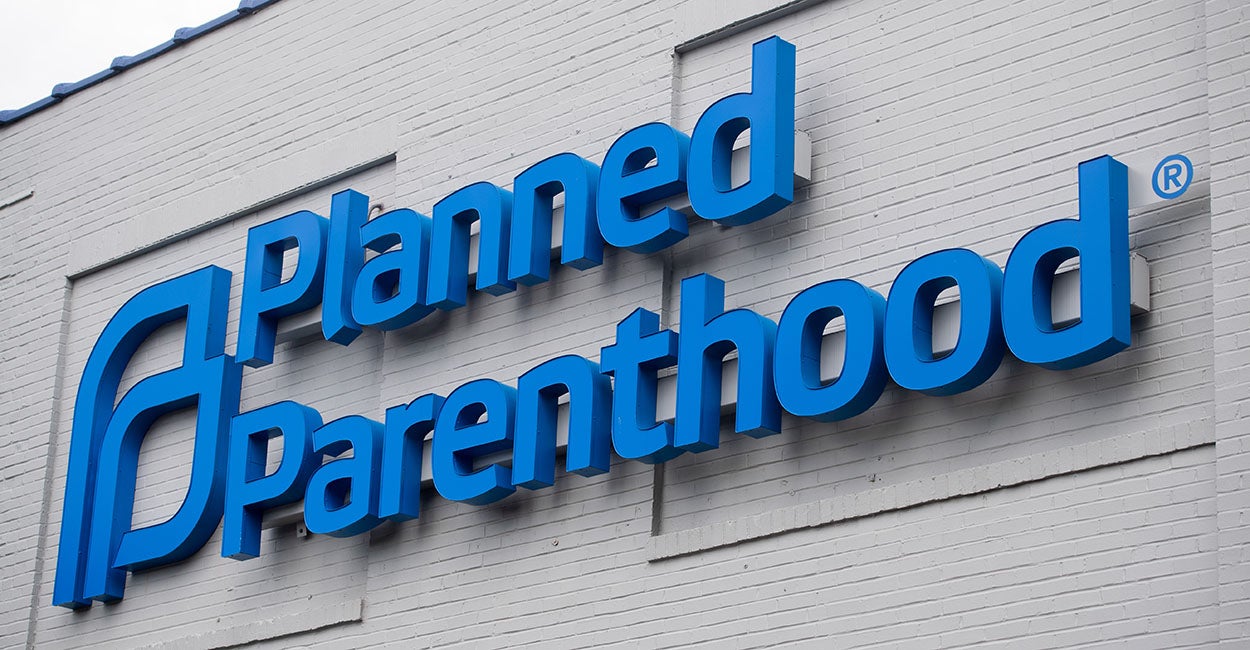If there were a fire in your house, what would you save?
It’s a timeless question, and one that’s been relevant in the COVID-19 pandemic. State officials have been forced to ask: To prevent loss of life from the novel coronavirus in our state, what should stay open? What is “essential”?
As state officials asked those questions this spring, one thing became clear: Preserving lives and medical resources was the priority. Elective surgeries—including abortion—could wait.
The Daily Signal depends on the support of readers like you. Donate now
>>> When can America reopen? The National Coronavirus Recovery Commission, a project of The Heritage Foundation, is gathering America’s top thinkers together to figure that out. Learn more here.
But the big abortion industry kept going. The list of states with ban orders on elective surgeries grew, with some states explicitly clarifying that abortions were included in the list of banned surgeries. And yet, big abortion kept going.
It has the makings of an inspirational story—“a little engine that could”—except in this case, it was a well-oiled machine determined to bolster its bottom line by killing innocent children and using desperately-needed medical supplies to do it.
While COVID-19 swept the world, the abortion industry made sure to defend its bottom line and to proactively advance its agenda at every turn.
As America turns to a new phase in its pandemic response, here’s a recap on what big abortion did in the states amid the worst of COVID-19—and what to expect next.
Early Responses From States and the Abortion Industry
Two months ago, when COVID-19 restrictions were just starting to become relevant in the United States, the primary focus was on social distancing. Places both public and private were still open, but the general population was encouraged to maintain safe distances, avoid large crowds, and stay home if they were sick.
As those recommendations grew into guidelines and even orders, there was an increased focus on personal protective equipment, particularly for doctors on the front lines fighting COVID-19, because of its contagious nature.
While the orders to preserve personal protective equipment evolved, at least two Planned Parenthood locations in Pennsylvania and California turned to the public for support, asking for donations of personal protective equipment, including masks and hand sanitizer.
At a time when states nationwide were doing all in their power to preserve medical supplies for the front lines, Planned Parenthood was asking for a share of the same supplies to perform abortions.
Bans on Elective Surgery in the States
About the same time, some states decided to start restricting or banning non-urgent elective surgeries. That was a highly unusual measure designed in large part to preserve personal protective equipment for front-line medical professionals.
Initially, half of the states issued those kinds of orders. In the end, 36 states would end up with some variation on a ban on elective surgeries, or at least a guidance recommending it.
The orders varied in how they defined what surgeries could continue; specifically, what was “essential.”
Some used exclusive lists: Certain enumerated services could remain, and everything else was temporarily halted. Others took a definitional approach: If the surgery met certain criteria, it would be considered “essential” or “nonessential,” depending on the state.
In one respect, they varied significantly; namely, whether states permitted abortion as an essential service.
Some states—such as Oregon and Virginia—explicitly permitted abortions to continue. Others, among them Texas and Ohio, explicitly clarified—either in their orders or in subsequent official statements—that abortion would not be permitted to continue in most or all circumstances as long as other surgeries were banned.
A majority of states left the issue unclear.
The Abortion Industry’s Early Response to the Bans
As the largest provider of abortions in America, Planned Parenthood had a vested interest in the way these state bans treated abortion. Initially, Planned Parenthood’s response to these bans varied, based on the location and the specifics of the order.
Early on, Ohio Planned Parenthood locations insisted they would continue performing abortions on the basis that they could comply with health orders and that they saw abortion as an essential procedure.
Among abortion centers in states where abortions were openly permitted to continue, some clinics—including non-Planned Parenthood facilities—saw an increase in the volume of women from out of state at their clinics.
In some states, abortion clinics even encouraged women to travel to receive an abortion, an ironic action in the midst of states shutting down to contain the spread of COVID-19. By encouraging interstate travel, the abortion industry may have risked the spread of the disease even further.
In Texas, where the attorney general clarified that abortions were temporarily proscribed, Planned Parenthood was swift to respond with a lawsuit.
That was quickly followed by lawsuits in other states, each led by Planned Parenthood, the ACLU, the Lawyering Project, and/or the Center for Reproductive Rights.
Those big-name abortion advocates filed lawsuits over the temporary abortion restrictions, either together or separately, in at least nine states as of this writing.
How the Abortion Lobby Won in Court
Abortion providers claimed that closing abortion clinics, even for a short time, was a violation of “a woman’s fundamental right to abortion.”
They claimed that even a couple of weeks’ cessation was unacceptable, even if the orders permitted abortion in certain circumstances. Any restriction was a burden, they claimed, because, in their view, abortion is always essential.
With the notable exceptions of Texas and Arkansas, the abortion lobby consistently received favorable court rulings in these cases—even in instances like in Alabama, where the government made huge concessions allowing certain abortions to proceed.
In that case, because the state limits the gestational age at which abortion is legal, if waiting for the order to expire would have pushed the abortion past the legal gestational age, a woman could still get the abortion right away. Nonetheless, Alabama lost in court.
Most states were even willing to stipulate that chemical abortions could continue to occur because they did not require as much in-person contact or personal protective equipment. However, many courts saw even a temporary restriction on surgical abortions as an undue burden and therefore unconstitutional.
Planned Parenthood cried foul, claiming governors and state attorneys general were targeting the abortion industry. At face value, though, the orders did not single out clinics, and state executives only spoke out to clarify that the orders did indeed apply to the abortion industry—just as with other industries providing elective surgeries.
Ironically, about the same time as these neutral health orders were issued and debated, several states issued meeting bans on churches that were not neutral and, in fact, targeted religious entities.
Some of those orders were held to unconstitutionally single out church attendees while allowing other groups that had been deemed essential to continue operating. However, other, similar orders that were implemented in an arbitrary way were allowed to remain.
That has caused many to wonder: Why is it that governors can’t target abortion when they can target religion?
Going Forward: How Reopening Strategies Impact Abortion
As states begin to reopen, most of the restrictions on elective surgeries are also being lifted. Medical centers are still being required to take precautions, but in many states procedures are being allowed to resume.
What does that mean for abortion? Because much of the concern about overwhelming the medical community or using precious personal protective equipment has lessened, things are gradually moving “back to normal” for the abortion industry.
The return to normalcy is happening in states such as Colorado, which never included abortion in its surgery restrictions, and even in Texas, which succeeded in its effort to temporarily halt abortions as an emergency measure.
Meanwhile, the states that are choosing to remain predominantly closed are generally left-leaning states. In those states, temporary restrictions on abortion were minor or nonexistent anyway, so continued closures will not uniquely affect abortion clinics in most cases.
But a “return to normalcy” does not mean the abortion industry is done taking advantage of the current crisis.
The Battle Over Abortion Telehealth Expansion
As the lawsuits began to slow down, Planned Parenthood went on offense. The abortion giant announced that it was making telehealth available in all 50 states in light of ongoing social distancing guidelines.
Depending on state laws, Planned Parenthood’s telehealth could mean abortion counseling, or it could mean abortionists actually prescribing medication abortions to women during a video consultation.
While telehealth can be a huge benefit to treat certain conditions and to provide access to needed health care services for vulnerable populations, abortion poses a serious threat to women and its track record suggests it should not be eligible for telemedicine.
As of Dec. 31, 2018, there were reports of 24 deaths of women associated with the abortion pill since the product was approved in September 2000. That includes women who, unbeknownst to the abortionist, had an ectopic pregnancy or sepsis. Those are conditions that are difficult to evaluate if the woman is not physically examined.
Planned Parenthood is not only advocating against temporary rules that protect the lives of women and children, preserve medical supplies, and hurt its business model. It’s also using the novel coronavirus as an opportunity to ignore safeguards and push for a boost to its bottom line.
As with the lawsuits, the broader abortion lobby has joined in the fight.
Several pro-abortion state attorneys general wrote to federal officials asking that they lift safeguards currently in place for the abortion pill. Those safeguards—including prohibiting an abortionist from sending abortion medications directly to a woman in the mail—are meant to protect women from serious health risks from the abortion pill.
But the pro-life movement is fighting back.
The organization we represent, Family Policy Alliance, joined in unity with other pro-life organizations who called on the Trump administration to prevent emergency funds from going to abortionists and to maintain existing safeguards around the abortion pill.
That was followed by an effort from 32 state-based family policy groups, who wrote a letter to federal officials that affirmed important safeguards to protect women. More than 200 state legislators sent a similar letter asking that the Food and Drug Administration continue to help women through existing protections.
This isn’t a fight that pro-life America can afford to lose because the lives of mothers and babies are at risk.
If the abortion lobby succeeds in its attempts to expand virtual abortion counseling and services, it would open a new frontier of opportunities for the industry.
For example, women who currently live far from an abortion clinic (and may need to take additional steps to procure an abortion) could now simply order an online visit with an abortionist to get a prescription, which she would then be taking far away from trained medical personnel.
If complications occur, she would be left alone to deal with them.
That expansion directly risks the lives of children, as well as the health and safety of women. Although lawsuits might be wrapping up, now is the time for pro-life advocates to work with extra diligence and wariness.
What We Learned and Where We Go Next
For the abortion industry and the pro-life movement alike, this season of pandemic and recovery is a critical moment to show where each group really stands.
With the series of lawsuits and the push for “telebortions,” the abortion industry has shown itself to be primarily concerned with preserving its bottom line—above public need and even above women’s safety.
At this critical juncture, the pro-life movement has an opportunity to show that it is holistically pro-life. The shutdowns themselves were at least in part about preserving life. During this time, pro-life leaders protected lives in two ways by including abortion in elective surgery bans. Now, they can save the lives of women and children by preventing the expansion of telemedicine abortions.
Pro-life leaders can also save lives by considering ways to responsibly reopen their states.
As governments and the medical community begin to get a handle on the pandemic, it’s important to remember that reopening states is not a simple equation. It’s easy to think of reopening as a question of lives versus money, but with suicide rates and unemployment skyrocketing, remaining closed for too long could mean pitting lives against lives.
There are multiple ways to affirm the value of all human life, and leaders should take into account both the medically at-risk and those at risk of dying from mental health issues or other effects of closure.
This is an opportunity for the pro-life community to demonstrate its holistic commitment to preserving life at all stages of development. One way to do that is by engaging with our local life-affirming pregnancy resource centers, which provide the emotional and physical support women need when facing an unexpected pregnancy.
Another way to help is to engage with pro-life lawmakers and organizations working at the state level, where most abortion decisions are made. That’s the kind of work that our organization does every day, together with partners from around the nation.
This is a unique time for America and for the pro-life movement. As leaders reflect on this time and what they deemed essential—what was worth saving in the fire—we hope that that the answer will be clear: We saved human life.





























